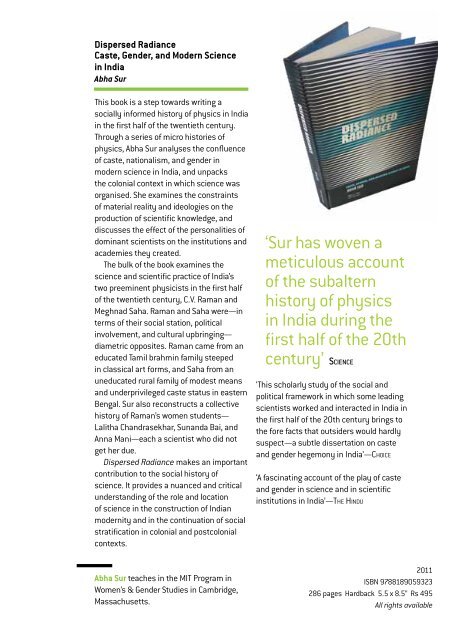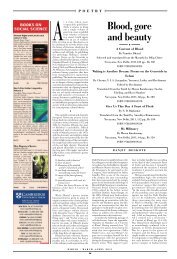etc - Navayana
etc - Navayana
etc - Navayana
You also want an ePaper? Increase the reach of your titles
YUMPU automatically turns print PDFs into web optimized ePapers that Google loves.
Dispersed Radiance<br />
Caste, Gender, and Modern Science<br />
in India<br />
Abha Sur<br />
This book is a step towards writing a<br />
socially informed history of physics in India<br />
in the first half of the twentieth century.<br />
Through a series of micro histories of<br />
physics, Abha Sur analyses the confluence<br />
of caste, nationalism, and gender in<br />
modern science in India, and unpacks<br />
the colonial context in which science was<br />
organised. She examines the constraints<br />
of material reality and ideologies on the<br />
production of scientific knowledge, and<br />
discusses the effect of the personalities of<br />
dominant scientists on the institutions and<br />
academies they created.<br />
The bulk of the book examines the<br />
science and scientific practice of India’s<br />
two preeminent physicists in the first half<br />
of the twentieth century, C.V. Raman and<br />
Meghnad Saha. Raman and Saha were—in<br />
terms of their social station, political<br />
involvement, and cultural upbringing—<br />
diametric opposites. Raman came from an<br />
educated Tamil brahmin family steeped<br />
in classical art forms, and Saha from an<br />
uneducated rural family of modest means<br />
and underprivileged caste status in eastern<br />
Bengal. Sur also reconstructs a collective<br />
history of Raman’s women students—<br />
Lalitha Chandrasekhar, Sunanda Bai, and<br />
Anna Mani—each a scientist who did not<br />
get her due.<br />
Dispersed Radiance makes an important<br />
contribution to the social history of<br />
science. It provides a nuanced and critical<br />
understanding of the role and location<br />
of science in the construction of Indian<br />
modernity and in the continuation of social<br />
stratification in colonial and postcolonial<br />
contexts.<br />
‘Sur has woven a<br />
meticulous account<br />
of the subaltern<br />
history of physics<br />
in India during the<br />
first half of the 20th<br />
century’ Science<br />
‘This scholarly study of the social and<br />
political framework in which some leading<br />
scientists worked and interacted in India in<br />
the first half of the 20th century brings to<br />
the fore facts that outsiders would hardly<br />
suspect—a subtle dissertation on caste<br />
and gender hegemony in India’—Choice<br />
‘A fascinating account of the play of caste<br />
and gender in science and in scientific<br />
institutions in India’—The Hindu<br />
Abha Sur teaches in the MIT Program in<br />
Women’s & Gender Studies in Cambridge,<br />
Massachusetts.<br />
2011<br />
ISBN 9788189059323<br />
286 pages Hardback 5.5 x 8.5” Rs 495<br />
All rights available




